
William enlisted in the Royal Navy at York on the 16 September 1903 as a Private, Register No 12270 of the Plymouth Division.
His date of birth is shown as the 10 February 1884, his address being Thornthwaite, Pateley Bridge, Yorkshire, his religion being C of E and his occupation is a farmer.
He is described as being 5’ 71/2” tall with fair complexion, Brown coloured hair and Grey coloured eyes with scars on his forehead and the back of his left hand.
From the 16.09.1903 - 6.07.1904 he was based at the receiving Depot at Deal in Kent where on the 01.02.1904 he was tested for the ability to swim which he passed.
From the 7.07.1904 - 29.01.1906 he was stationed at Plymouth in Devon.
From the 30.01.1906 - 3.02.1908
he was stationed on board HMS Argyll, a Devonshire class armoured
Cruiser built by Scotts of Greenock and launched on the 3 March 1904
and finally completed in December 1905, this being the second vessel to
bear this name.
Cruiser built by Scotts of Greenock and launched on the 3 March 1904
and finally completed in December 1905, this being the second vessel to
bear this name.
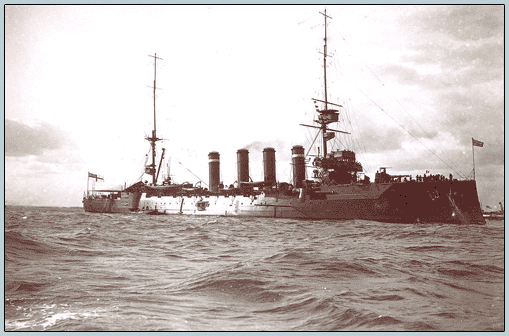
HMS Argyll was armed with four 7-inch and six 6-inch guns, she displaced 10,850 tons and her
21,190 horsepower engines produced 22.4 knots through her twin screws.
She was 450 feet long, with a beam of 68 feet and a draught of 25 feet.
Her complement was between 655 and 700 men. She served with the 1st Cruiser Squadron in the
Atlantic in 1906/7, the Channel between 1907 and 1909 and joined the 5th Cruiser Squadron for
service in the Atlantic in 1909 and 1912. At the outbreak of war, HMS Argyll was in the 3rd cruiser
Squadron, with the Grand Fleet at Scapa Flow.
She patrolled in the Shetlands area and captured a German merchantman on 6 August 1914, and
in November 1914 was redeployed to Rosyth as an anti-invasion and anti-raiding force.
On 24 November 1914, HMS Argyll took part in an aborted raid on Heligoland and Cuxhaven. Thereafter, she was employed mainly on patrol off the north east coast of Scotland. It was in the course
of one of these patrols on the night of 28 October 1915 that the Argyll ran aground on the Bell Rock, whose light had been extinguished by order of the Admiralty.
Although there were no fatalities, the ship became a total wreck with only the 6-inch guns being salvaged.
21,190 horsepower engines produced 22.4 knots through her twin screws.
She was 450 feet long, with a beam of 68 feet and a draught of 25 feet.
Her complement was between 655 and 700 men. She served with the 1st Cruiser Squadron in the
Atlantic in 1906/7, the Channel between 1907 and 1909 and joined the 5th Cruiser Squadron for
service in the Atlantic in 1909 and 1912. At the outbreak of war, HMS Argyll was in the 3rd cruiser
Squadron, with the Grand Fleet at Scapa Flow.
She patrolled in the Shetlands area and captured a German merchantman on 6 August 1914, and
in November 1914 was redeployed to Rosyth as an anti-
of one of these patrols on the night of 28 October 1915 that the Argyll ran aground on the Bell Rock, whose light had been extinguished by order of the Admiralty.
Although there were no fatalities, the ship became a total wreck with only the 6-
From the 04.02.1908 - 29.06.1908 William was stationed at Plymouth.
From the 30.06.1908 - 24.07.1908
He was stationed on board HMS Mars a Majestic class pre-dreadnought
battleship launched on the 30 March 1896 and sold for break up in 1921.
From the 30.06.1908 -
HMS Mars was armed with four 12 in guns, twelve 6 in quick firing guns, sixteen 12 pdr quick firing
guns, twelve 2 pdr quick firing guns and five 18 in torpedo tubes, four submerged, she displaced
15,730-16,060 tons and her engines produced a top speed of 17 knots. She was 421 feet long.
Her complement was 672 men.
She served as a guard ship before being disarmed and used as a troopship. At the start of 1914 the
Mars was in the 4th Division of the Home Fleet, part of the reserve. At the start of the war she was
sent to the Humber, to form part of a new 9th Battle Squadron. She remained there until December,
when she was moved south to join the Duncan class battleships at Portland, initially to take part in
a planned attack on Zeebrugge.
In February 1915 she was moved to Belfast, and her 12in guns were removed to arm the Lord Clive
class monitors Earl of Peterborough and Sir Thomas Picton. The Mars was then used as a
troopship – in September 1915 Mars, Magnificent and Hannibalwere all used to take troops to the Mediterranean.
At the end of the Gallipoli campaign Mars and Magnificent were used to evacuate the troops – during the 18-19 December evacuated Mars was able to carry 2,000 troops, while on 8-9 January 1916 at
Helles Mars and Prince George took 3,400 troops.
This ended the active career of the Mars, and she was paid off to become a depot ship.
guns, twelve 2 pdr quick firing guns and five 18 in torpedo tubes, four submerged, she displaced
15,730-
Her complement was 672 men.
She served as a guard ship before being disarmed and used as a troopship. At the start of 1914 the
Mars was in the 4th Division of the Home Fleet, part of the reserve. At the start of the war she was
sent to the Humber, to form part of a new 9th Battle Squadron. She remained there until December,
when she was moved south to join the Duncan class battleships at Portland, initially to take part in
a planned attack on Zeebrugge.
In February 1915 she was moved to Belfast, and her 12in guns were removed to arm the Lord Clive
class monitors Earl of Peterborough and Sir Thomas Picton. The Mars was then used as a
troopship – in September 1915 Mars, Magnificent and Hannibalwere all used to take troops to the Mediterranean.
At the end of the Gallipoli campaign Mars and Magnificent were used to evacuate the troops – during the 18-
This ended the active career of the Mars, and she was paid off to become a depot ship.
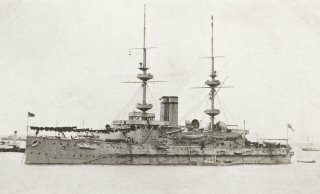
From the 25.07.1908 - 17.08.1908 William was stationed at Plymouth.
From the 18.08.1908 - 01.08.1910
He was stationed on board HMS Majestic a Majestic class pre-dreadnought
battleship launched on In 1895 and sunk by U Boat 21 on the 27 May 1915.
From the 18.08.1908 -
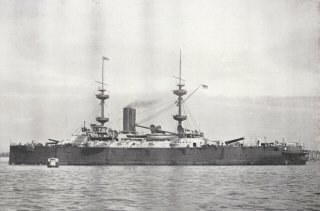
HMS Majestic
HMS Majestic was armed with four 12in guns, twelve 6 in quick firing guns, sixteen 12 pdr quick firing guns,
twelve 2 pdr quick firing guns and five 18 in torpedo tubes, four submerged, she displaced 15,730-16,060 tons
and her engines produced a top speed of 17 knots. She was 421 feet long.
Her complement was 672 men.
During the First World War she saw service with the Dover Patrol and at the Dardanelles, where she became
the only member of the class to be sunk in action.
The Majestic was the flagship of the Channel Fleet from 1895-1903. She then served with the Atlantic Fleet
(1906) before entering the Commissioned Reserve. From May 1912 she was part of the 3rd Fleet, a reserve
Formation.
At the outbreak of the First World War, HMS Majestic was in the Devonport dockyard, but she was soon
returned to active duty as part of the 7th Battle Squadron of the Channel Fleet. It had been intended to place
all nine Majestic class ships into the squadron, but only two ever reached it, the
rest being detached for other duties. Even the Majestic did not remain with the squadron for long. In October
1915, the Majestic was detached from the Channel Fleet to strengthen the escort for the first Canadian troop
convoy to cross the Atlantic, reaching the planned rendezvous spot on 7 October. It had been expected that
this convoy would contain at most fourteen transport ships, but recruitment in Canada exceeded all expectations, and the convoy more than doubled in size. The convoy left Canada on 5 October, and
met the Majestic on 9 October, reaching England on 14 October.
On her return from this duty, the Majestic rejoined the Channel Fleet, forming part of the Dover Patrol. In early November the Germans raided Gorleston and Yarmouth. At the time of the raid, the Majestic
was at the Nore, with three other pre-dreadnought battleships. She was ordered to prepare to sail, but wasn’t used in the operations that followed. In November she was sent to the Humber, to act as a
guard ship for the secondary naval base in the estuary. This was the British naval base closest to the German naval base at Wilhelmshaven, and was seen as potentially vulnerable. There she joined her
sister ships Victorious and Mars, and was soon joined by the Jupiter.
This concentration was short-lived. In December the anti-submarine boom at Dover had been blown away in a gale. Until then the more modern Duncan class battleships had been based at Dover, but it
was now felt to be too dangerous to keep them there, and they were moved away. HMS Majestic and HMS Mars were called south to replace them. There followed a period of some frustration, in which a
number of plans were made to attack German positions on the Belgian coast, including one plan for a combined operation against Zeebrugge. Only one of the plans that involved the Majestic was actually
carried out – a bombardment of German gun batteries on 15-16 December. Even then the Majestic was recalled after the first day, leaving only the even older battleship HMS Revenge to take part. She
was then hit by two 8in shells and forced to return to dock for repairs.
In early 1915 HMS Majestic was sent to the Dardenelles to form part of the big Anglo-French battleship squadron that was involved in naval attacks on the Turkish forts at the entrance to the straits.
On 26 February, along with HMS Albion and HMS Triumph she made the first opposed entry of warships into the Dardanelles for a century as part of a combined operation that also saw marines land on
the Gallipoli peninsula. For this attack howitzers were mounted on the roofs of the 12 in gun turrets.
The three battleships entered the Dardanelles at 8.00am. The Majestic’s first target was a bridge over the Mendere River, which was damaged but not destroyed. By noon she was using her big guns
against Fort Dardanos. During the day the ships moved further into the straits, and came under increasingly heavy fire from hidden Turkish howitzers. The Majestic was hit by one 6in howitzer shell
below the water line, which caused a minor leak. At 4.00pm the operation battleships were withdrawn from the straits.
The Majestic took part in the unsuccessful attempt to force the straits on 18 March 1915. She was then used to support the Anzac landings at Gaba Tepe at the start of the Gallipoli campaign.
In the early phase of the Gallipoli campaign the battleships were able to provide valuable support to the troops. However, in May the German submarine U 21 reached the area, and the situation soon
changed. On 25 May HMS Triumph was sunk by U 21. The remaining battleships withdrew overnight, then took extra precautions. On 27 May the Majestic took up a position close to shore, protected
by submarine nets and, surrounded by a fleet of transport ships, unloaded supplies. It was hoped that this position would allow her to keep firing while protecting her against the submarine, which it was
half-believed had been rammed on the previous day.
At 6.45am this optimistic attitude was proved to be false. U 21 was spotted 400 yards from the ship. Moments later two torpedoes were fired through gaps in the lines of transports. Both hit the Majestic,
and within seven minutes she capsized. The loss of life was surprisingly low – it very quickly became clear that the ship was sinking, and the order to abandon ship was given. Of her crew of nearly 700,
only 40 were lost, mostly in the initial explosion but some when they became entangled in the submarine nets. The loss of two battleships in three days had a serious impact on the Gallipoli campaign,
seriously reducing the amount of support the navy could offer the army.
The Official History of War, when describing the sinking, described the Majestic as “the famous ship, the pride of the old Channel fleet, in whose design the whole thought and experience of the Victorian
era had culminated”
twelve 2 pdr quick firing guns and five 18 in torpedo tubes, four submerged, she displaced 15,730-
Her complement was 672 men.
During the First World War she saw service with the Dover Patrol and at the Dardanelles, where she became
the only member of the class to be sunk in action.
The Majestic was the flagship of the Channel Fleet from 1895-
Formation.
At the outbreak of the First World War, HMS Majestic was in the Devonport dockyard, but she was soon
returned to active duty as part of the 7th Battle Squadron of the Channel Fleet. It had been intended to place
all nine Majestic class ships into the squadron, but only two ever reached it, the
rest being detached for other duties. Even the Majestic did not remain with the squadron for long. In October
1915, the Majestic was detached from the Channel Fleet to strengthen the escort for the first Canadian troop
convoy to cross the Atlantic, reaching the planned rendezvous spot on 7 October. It had been expected that
this convoy would contain at most fourteen transport ships, but recruitment in Canada exceeded all expectations, and the convoy more than doubled in size. The convoy left Canada on 5 October, and
met the Majestic on 9 October, reaching England on 14 October.
On her return from this duty, the Majestic rejoined the Channel Fleet, forming part of the Dover Patrol. In early November the Germans raided Gorleston and Yarmouth. At the time of the raid, the Majestic
was at the Nore, with three other pre-
sister ships Victorious and Mars, and was soon joined by the Jupiter.
This concentration was short-
number of plans were made to attack German positions on the Belgian coast, including one plan for a combined operation against Zeebrugge. Only one of the plans that involved the Majestic was actually
carried out – a bombardment of German gun batteries on 15-
In early 1915 HMS Majestic was sent to the Dardenelles to form part of the big Anglo-
the Gallipoli peninsula. For this attack howitzers were mounted on the roofs of the 12 in gun turrets.
The three battleships entered the Dardanelles at 8.00am. The Majestic’s first target was a bridge over the Mendere River, which was damaged but not destroyed. By noon she was using her big guns
against Fort Dardanos. During the day the ships moved further into the straits, and came under increasingly heavy fire from hidden Turkish howitzers. The Majestic was hit by one 6in howitzer shell
below the water line, which caused a minor leak. At 4.00pm the operation battleships were withdrawn from the straits.
The Majestic took part in the unsuccessful attempt to force the straits on 18 March 1915. She was then used to support the Anzac landings at Gaba Tepe at the start of the Gallipoli campaign.
In the early phase of the Gallipoli campaign the battleships were able to provide valuable support to the troops. However, in May the German submarine U 21 reached the area, and the situation soon
changed. On 25 May HMS Triumph was sunk by U 21. The remaining battleships withdrew overnight, then took extra precautions. On 27 May the Majestic took up a position close to shore, protected
by submarine nets and, surrounded by a fleet of transport ships, unloaded supplies. It was hoped that this position would allow her to keep firing while protecting her against the submarine, which it was
half-
and within seven minutes she capsized. The loss of life was surprisingly low – it very quickly became clear that the ship was sinking, and the order to abandon ship was given. Of her crew of nearly 700,
only 40 were lost, mostly in the initial explosion but some when they became entangled in the submarine nets. The loss of two battleships in three days had a serious impact on the Gallipoli campaign,
seriously reducing the amount of support the navy could offer the army.
The Official History of War, when describing the sinking, described the Majestic as “the famous ship, the pride of the old Channel fleet, in whose design the whole thought and experience of the Victorian
era had culminated”
Somehow ( his service record shows he was on board ship ) on the 29 May 1909 William married Mabel Moon Austin in Plymouth.
From the 02.08.1910 - 03.10.1910 William was stationed at Plymouth during which his son
Albert Edward was born on the 13 September 1910.
From the 04.08.1910 - 07.01.1916
He was stationed on board HMS Gloucester a Bristol class light Cruiser launched on
the 28 October 1909 and sold for break up in May 1921.
From the 02.08.1910 -
Albert Edward was born on the 13 September 1910.
From the 04.08.1910 -
He was stationed on board HMS Gloucester a Bristol class light Cruiser launched on
the 28 October 1909 and sold for break up in May 1921.
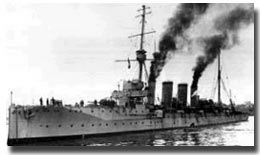
HMS Gloucester was armed with two 6in guns, one aft and one forward, ten 4 in guns, five on each side,
four 3 pdrs, two 18 submerged torpedo tubes (beam), she displaced 5300 tons and her engines produced
a top speed of 25 knots. She was 453 feet long. Her complement was 480 men.
During the First World War she took part in the early hunts for German commerce raiders and was present
at the Battle of Jutland.
Like the rest of the Bristol class cruisers she spent most of her active career on overseas stations.
On completion she joined the 1st Battle Squadron, part of the Home Fleet. In January 1913 she joined the
2nd Light Cruiser Squadron, then based in the Mediterranean. At the outbreak of the First World War she
took part in the search for the Goeben and the Breslau, two German cruisers that made up their
Mediterranean Squadron. Those ships successfully evaded the British hunt, reaching Constantinople, where
they were officially given to the Turks.
She then took part in the hunt for the commerce raider SMS Emden (November 1914) and then for the AMC
Kronprinz Wilhelm, a second commerce raider believed to be off the African coast.
The Kronprinz Wilhelm, a converted passenger liner, captured 15 ships before a shortage of coal forced her to seek internment in the United States (26 April 1915).
In February 1915 the Gloucester joined the 3rd Light Cruiser Squadron in home waters.
four 3 pdrs, two 18 submerged torpedo tubes (beam), she displaced 5300 tons and her engines produced
a top speed of 25 knots. She was 453 feet long. Her complement was 480 men.
During the First World War she took part in the early hunts for German commerce raiders and was present
at the Battle of Jutland.
Like the rest of the Bristol class cruisers she spent most of her active career on overseas stations.
On completion she joined the 1st Battle Squadron, part of the Home Fleet. In January 1913 she joined the
2nd Light Cruiser Squadron, then based in the Mediterranean. At the outbreak of the First World War she
took part in the search for the Goeben and the Breslau, two German cruisers that made up their
Mediterranean Squadron. Those ships successfully evaded the British hunt, reaching Constantinople, where
they were officially given to the Turks.
She then took part in the hunt for the commerce raider SMS Emden (November 1914) and then for the AMC
Kronprinz Wilhelm, a second commerce raider believed to be off the African coast.
The Kronprinz Wilhelm, a converted passenger liner, captured 15 ships before a shortage of coal forced her to seek internment in the United States (26 April 1915).
In February 1915 the Gloucester joined the 3rd Light Cruiser Squadron in home waters.
From the 08.01.1916 - 14.03.1916 William was stationed at Plymouth.
From the 15.03.1916 - 31.12.1918
He was once again stationed on HMS Gloucester.
In April 1916 she took part in the suppression of the Easter Uprising in Ireland, shelling Galway.
The 1st, 2nd and 3rd Light Cruiser Squadrons were all part of the Battlecruiser fleet during the Battle of Jutland and whilst two of that fleet’s battlecruisers were lost, the light cruisers survived intact.
The Gloucester spend the rest of the war in the Adriatic with the 8th Light Cruiser Squadron (December 1916-November 1918). She was put into the reserve in 1919 and sold for scrap in 1921.
HMS Bellona was armed with six 4 in 50 calibre Mk VIII guns, four 3 pdr guns, two 18 in deck mounted torpedo tubes, port and starboard, she displaced 3800 tons and her engines produced a top speed
of 25 knots. She was 405 feet long. Her complement was 317 men.
HMS Bellona was originally built to work with the destroyer flotillas. In 1909 she became the Senior Officer’s ship of the 2nd Flotilla, made up of 25.5knots River class destroyers, and was already
of 25 knots. She was 405 feet long. Her complement was 317 men.
HMS Bellona was originally built to work with the destroyer flotillas. In 1909 she became the Senior Officer’s ship of the 2nd Flotilla, made up of 25.5knots River class destroyers, and was already
only just fast enough to cope. When these destroyers were replaced by Acorn class destroyers capable of reaching 27knots, the Bellona was too slow to keep up with her own flotilla and in 1912 she
was removed from the flotilla.
In August 1914 she joined the Grand Fleet, and was attached to the First Battle Squadron at Scapa Flow (each battleship squadron had a single light cruiser attached). She was present at the
Battle of Jutland (31 May-1 June 1916) although did not make any significant contribution to the fight – as the battle fleet approached the fighting the light cruisers were sent to the rear to put them out
of harms way.
In June 1917 the Bellona was converted to a minelayer. In that capacity she carried out four missions, laying 306 mines. She was paid off in 1919.
From the 01.01.1919 - 06.07.1919
He was stationed on board HMS Bellona a Boadicea class scout Cruiser launched on the 20 March 1909 and sold for break up in May 1921. This being the 7th vessel to
carry this name.
carry this name.
From the 07.07.1919 - 10.10.1919
He was stationed on board HMS Collosus.
HMS Colossus was Built by Scotts of Greenock and launched on the 9th of April 1910 and commissioned into the Royal Navy on the 8th August 1911.
HMS Colossus was Built by Scotts of Greenock and launched on the 9th of April 1910 and commissioned into the Royal Navy on the 8th August 1911.
HMS Colossus joined the 2nd Division of the Home Fleet and the 2nd Battle Squadron between May and December
1912 and in August 1914 she became Flagship to the 1st battle squadron. She fought at the Battle of Jutland under
the command of Admiral Jellicoe being the only ship under his command to be damaged by two hits, with five crew
Casualties.
After The Great War, HMS Colossus became a cadet training ship in September 1921 and eventually sold for
scrapping in August 1928.
Displacement 20,350 tons Speed 21.5 knots Compliment 750 and up to 800 during wartime Armament.
Ten 12-inch guns in pairs. and sixteen 4 -inch guns Two 3 inch Anti Aircraft Guns.
1912 and in August 1914 she became Flagship to the 1st battle squadron. She fought at the Battle of Jutland under
the command of Admiral Jellicoe being the only ship under his command to be damaged by two hits, with five crew
Casualties.
After The Great War, HMS Colossus became a cadet training ship in September 1921 and eventually sold for
scrapping in August 1928.
Displacement 20,350 tons Speed 21.5 knots Compliment 750 and up to 800 during wartime Armament.
Ten 12-
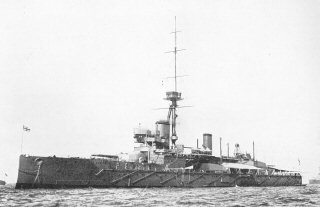
HMS Collossus
From the 11.10.1919 - 17.02.1920 William was stationed at Plymouth.
From the 18.02.1920 - 08.08.1923
He was stationed on HMS Delhi.
On the 01.01.1923 his rank was changed to Marine
From the 18.02.1920 -
On the 01.01.1923 his rank was changed to Marine
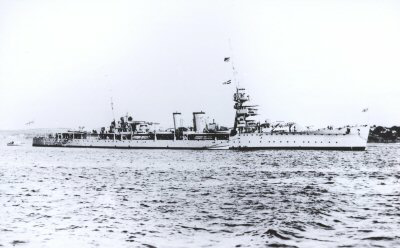
HMS Delhi - 1925
Displacement: 4,850 tons Speed: 29knots Complement: 450 increasing to 469 as a Flagship.
Armament: Six 6 inch and three 4 inch anti-aircraft guns and two 2 pdr anti-aircraft guns. Twelve 21 inch torpedo tubes.
HMS Dehli was fitted with five 5 inch de-perming and eight 2 pdr anti-aircraft guns. HMS Dauntless and HMS Durban
served in China with Danae during 1939-41, both ships switching to the Eastern fleet in 1942-43.
Dauntless then served as a training ship from 1943-45, while Durban served the home fleet until 1944.
HMS Dehli served with the Home fleet in 1939 and 1942, the Mediterranean fleet in 1940 and 1943-45.
After a stretch in the South Atlantic from 1941-42 during which she was refitted in the USA, she was placed in reserve
in 1945.
Armament: Six 6 inch and three 4 inch anti-
From the 09.08.1923 - 15.09.1924 William was stationed at Plymouth after which date he was discharged with a pension and described as having a ‘Very Good’
general character.
On the 16.09.1924 he was enrolled in the Royal Fleet Reserve Class ‘A’ and remained stationed In Plymouth until being discharged on the 09.02.1934 at the Age of
50 years old.
William was awarded the Royal Navy Long Service & Good Conduct medal as well as the 1914-1915 Star and the British War and Victory medals.
general character.
On the 16.09.1924 he was enrolled in the Royal Fleet Reserve Class ‘A’ and remained stationed In Plymouth until being discharged on the 09.02.1934 at the Age of
50 years old.
William was awarded the Royal Navy Long Service & Good Conduct medal as well as the 1914-